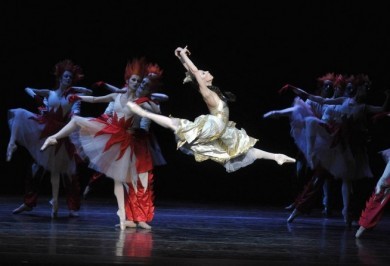Libretto by Maxim Isaev after the tale of Pyotr Yershov
"The music for the ballet The Little Humpbacked Horse is an early, a very early, work of mine. But it is the work of an era important in terms of my emergence as a composer and which defined much in my life. A work with which I firmly "grasped" the unearthly Firebird – Maya Plisetskaya. The score is dedicated to her…
The current production of The Little Humpbacked Horse at the Mariinsky is a long-awaited pleasure. Years ago, then still young but clearly remarkable for his outstanding gift, Valery Gergiev staged a production of The Little Humpbacked Horse at the Mariinsky. Later, several times he dazzlingly performed highlights from the ballet at concerts. It was totally his suggestion to revive this ballet now. Which means that even today the score of The Little Humpbacked Horse raises a compassionate emotional response and enthusiasm in his musically charged soul. How it inspires me!
Alexei Ratmansky is today acclaimed everywhere as one of the most vibrant choreographers of the age. I always dreamed that he would turn his visions and ears on The Horse.
It seemed and seems to me that it is close to his unique, witty individuality of theme, where lyricism and humour, craftiness and light sadness are natural neighbours. I find it so interesting how he will "straighten out" Yershov´s undying tale…
The Mariinsky´s orchestra is, today, renowned and famed throughout the world. It is one of the finest orchestras on Planet Earth at the present time. It is by no means hard to imagine how much the composer wishes to hear the musicians perform this "odd" score!
Lastly, the ballet company is a legend of the Mariinsky. Its glittering stars who have expressed a desire to perform in the premiere…
This is the generous gift the composer is to receive from his creative destiny this evening at the theatre!
Of course, "from today" I see much naivety and imperfection in my youthful work.
But the score was written with sincerity, honesty and enthusiasm. I imagine that this can be heard and sensed even now. "I do not reject every line of the past," as Andrei Voznesensky wrote.
I, too, have no such intentions. Rather I am filled with a sensation of pleasurable anticipation of happiness and artistic creativity."
Rodion Shchedrin
4 March 2009
The Little Humpbacked Horse is a successful blend of many of the ingredients necessary for success – the fairy-tale plot so attractive for children, the ironic interpretation that is interesting for adults, the extravagant and stylish designs by Maxim Isaev, the talented and inventive choreography of Alexei Ratmansky and the emotional music of Rodion Shchedrin.
The score of the ballet The Little Humpbacked Horse was written by the young Shchedrin, then still a student at the Moscow Conservatoire. With its humour, mischief, colourfulness and affirmation of life it has inspired many musicians and choreographers. Everyone can find something individual in it. Alexander Radunsky, the choreographer of the first version of Shchedrin’s The Little Humpbacked Horse at the Bolshoi Theatre (1960), heard a traditional ballet fairy-tale in it, with ballerina princesses, tsars who didn’t dance very much and traditional divertissements that filled the ballet with dance. Igor Belsky, who staged his own version of The Little Humpbacked Horse at the Maly Opera in 1963, heard sharp satire in the music. First and foremost this concerned the image of the Tsar; it also matched the literary basis, Yershov’s fairy-tale, and the ideological framework of the age when the score was composed. The Tsar in Belsky’s ballet unambiguously brought Khrushchev to mind with his gestures. In 1981 Dmitry Bryantsev staged his own version at the Kirov Theatre, combining fairground decorativeness with incredibly human portraits of the protagonists.
Ratmansky’s ballet is a child of the early 21st century; in this dynamic, merry and ironic production there is also enough room for the dance itself, both classical and character, mime scenes, serious virtuoso skill and reckless humour. Interestingly, Ratmansky’s humour comes not at all from the playful scenes, mimes or gestures; the choreographer can make the audience smile through the actual dance. His divertissement in the production is a witty paraphrase on the theme of traditional divertissement character pieces. From the standpoint of a contemporary postmodernist, the choreographer looked at the old tradition of “revising” folkloric dance steps for classical productions, and he has brought this to life with a bold sense of humour. Recognising the quotations gives the choreography historic depth, and without having to solve the enchantingly ironic rebuses the production is engaging enough in its merriment. The dances conjured up by the choreographer are also interesting for the dancers, each role opening up a broad expanse in which to be creative – on the one hand, for acting skills and improvisation and, on the other, to test themselves with this technically demanding dance text. If, in the role of the amusing and grotesquely presented duffer that is the Tsar the playful element is richer than the dance component and the expressions of the “splinted” Father and Brothers of Ivan are simple in terms of the movements, then Ivan the Fool and the Tsar Maiden, in some scenes childishly capricious and in others virginally tender, and the fleet-footed and dexterous Horse reveal their characters through the dance.
Olga Makarova
 Mariinsky Theatre:
Mariinsky Theatre:  Mariinsky-2 (New Theatre):
Mariinsky-2 (New Theatre):  Mariinsky Concert Hall:
Mariinsky Concert Hall: 

